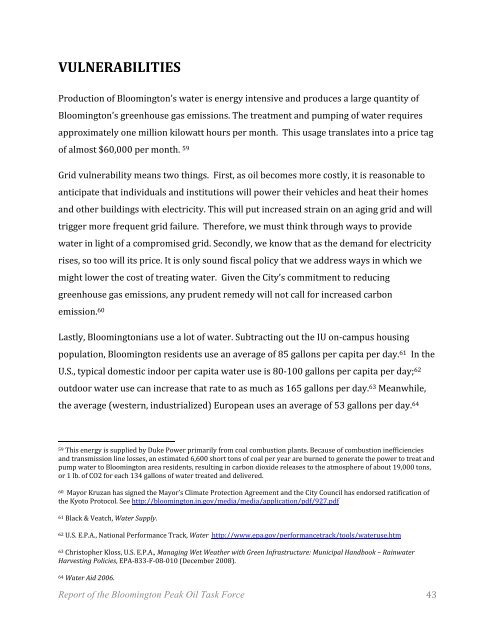Peak Oil Task Force Report - City of Bloomington - State of Indiana
Peak Oil Task Force Report - City of Bloomington - State of Indiana
Peak Oil Task Force Report - City of Bloomington - State of Indiana
You also want an ePaper? Increase the reach of your titles
YUMPU automatically turns print PDFs into web optimized ePapers that Google loves.
VULNERABILITIES<br />
Production <strong>of</strong> <strong>Bloomington</strong>’s water is energy intensive and produces a large quantity <strong>of</strong><br />
<strong>Bloomington</strong>’s greenhouse gas emissions. The treatment and pumping <strong>of</strong> water requires<br />
approximately one million kilowatt hours per month. This usage translates into a price tag<br />
<strong>of</strong> almost $60,000 per month. 59<br />
Grid vulnerability means two things. First, as oil becomes more costly, it is reasonable to<br />
anticipate that individuals and institutions will power their vehicles and heat their homes<br />
and other buildings with electricity. This will put increased strain on an aging grid and will<br />
trigger more frequent grid failure. Therefore, we must think through ways to provide<br />
water in light <strong>of</strong> a compromised grid. Secondly, we know that as the demand for electricity<br />
rises, so too will its price. It is only sound fiscal policy that we address ways in which we<br />
might lower the cost <strong>of</strong> treating water. Given the <strong>City</strong>’s commitment to reducing<br />
greenhouse gas emissions, any prudent remedy will not call for increased carbon<br />
emission. 60<br />
Lastly, <strong>Bloomington</strong>ians use a lot <strong>of</strong> water. Subtracting out the IU on‐campus housing<br />
population, <strong>Bloomington</strong> residents use an average <strong>of</strong> 85 gallons per capita per day. 61 In the<br />
U.S., typical domestic indoor per capita water use is 80‐100 gallons per capita per day; 62<br />
outdoor water use can increase that rate to as much as 165 gallons per day. 63 Meanwhile,<br />
the average (western, industrialized) European uses an average <strong>of</strong> 53 gallons per day. 64<br />
59 This energy is supplied by Duke Power primarily from coal combustion plants. Because <strong>of</strong> combustion inefficiencies<br />
and transmission line losses, an estimated 6,600 short tons <strong>of</strong> coal per year are burned to generate the power to treat and<br />
pump water to <strong>Bloomington</strong> area residents, resulting in carbon dioxide releases to the atmosphere <strong>of</strong> about 19,000 tons,<br />
or 1 lb. <strong>of</strong> CO2 for each 134 gallons <strong>of</strong> water treated and delivered.<br />
60 Mayor Kruzan has signed the Mayor’s Climate Protection Agreement and the <strong>City</strong> Council has endorsed ratification <strong>of</strong><br />
the Kyoto Protocol. See http://bloomington.in.gov/media/media/application/pdf/927.pdf<br />
61 Black & Veatch, Water Supply.<br />
62 U.S. E.P.A., National Performance Track, Water http://www.epa.gov/performancetrack/tools/wateruse.htm<br />
63 Christopher Kloss, U.S. E.P.A., Managing Wet Weather with Green Infrastructure: Municipal Handbook – Rainwater<br />
Harvesting Policies, EPA‐833‐F‐08‐010 (December 2008).<br />
64 Water Aid 2006.<br />
<strong>Report</strong> <strong>of</strong> the <strong>Bloomington</strong> <strong>Peak</strong> <strong>Oil</strong> <strong>Task</strong> <strong>Force</strong><br />
43









